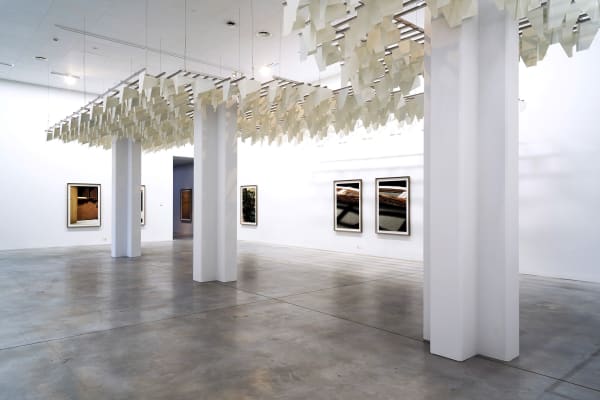Martin Boyce: HOUSE OF CARD: M Leuven, Leuven, Belgium
‘HOUSE OF CARD’ offers an overview of various approaches to construction in Demand’s oeuvre from the past fifteen years. His work related to models, scenography and even buildings are closely related to architecture At the same time ‘HOUSE OF CARD’ shows the connection between Demand’s projects and those of other influential artists, architects and designers like Martin Boyce, Arno Brandlhuber, Caruso St John en Rirkrit Tiravanija.
The title ‘HOUSE OF CARD’ refers to the precariousness of Demand's practice as a builder. Whereas architecture generally equates with permanence, Demand prefers to explore the limits of the ephemeral, as is evidenced in his use of paper and cardboard.
The work of the German artist Thomas Demand (1964) balances between fiction and reality. Although trained as a sculptor, Demand’s main medium is photography, which he uses to record his ephemeral life-size models made of coloured paper and cardboard. By destroying the paper constructions once the photograph has been taken, their only raison d’être is the final photographic image.
Demand’s work is often based on pre-existing historical or contemporary found images taken from the media, from books or online sources. By meticulously constructing photographs based on self-made models, he deliberately removes his compositions from the images they are supposed to depict.
The exhibition centres on Demand’s ongoing series of 'Model Studies', which are connected to the works of other influential artists, architects and designers. In three rooms M shows his series ‘Model Studies’ (2011 – today), in which the concept of the model takes a central place as the space. In ‘Model Studies’, Demand abandons his usual practice. Here, for the first time, he does not photograph his own self-built scale models, but rather those of other artists, architects and designers, including John Lautner, SANAA (Kazuyo Sejima + Ryue Nishizawa), Hans Hollein and Azzedine Alaïa. This results in series of images which come across as abstract and highly tactile through the textures and materials depicted. Among others, M is presenting the first series of 'Model Studies', which were based on the work of John Lautner, along with the sculpture 'Do Words Have Voices' (2011) by the British artist Martin Boyce.
In addition to his series of ‘Model Studies’, the exhibition provides an overview of Demand’s architectural interests and designs covering the past fifteen years. It presents several rarely exhibited projects, such as 'Black Label' from 2009, ‘Embassy’ from 2007 (a collaboration with the German architect Arno Brandlhuber), ‘Nagelhaus’ from 2010 (a non-realized project in collaboration with Caruso St John), and ‘Kvadrat pavilions’, involving a design by Demand which is currently being executed next to the head office of textile giant Kvadrat in Denmark.
In the context of the exhibition, a new monograph on the work of Thomas Demand will appear. Published by M Leuven and MACK London, the book’s design is by Julie Peeters. This monograph contains essays by Maristella Casciato & Emily Pugh, Aude-Line Dulière, Karen Van Godtsenhoven, Valerie Verhack and Adam Caruso, as well as the text of a conversation between Thomas Demand, Hal Foster and David Chipperfield. The book also contains visuals contributions by Martin Boyce, Arno Brandlhuber and Rirkrit Tiravanija.
Curator: Valerie Verhack



